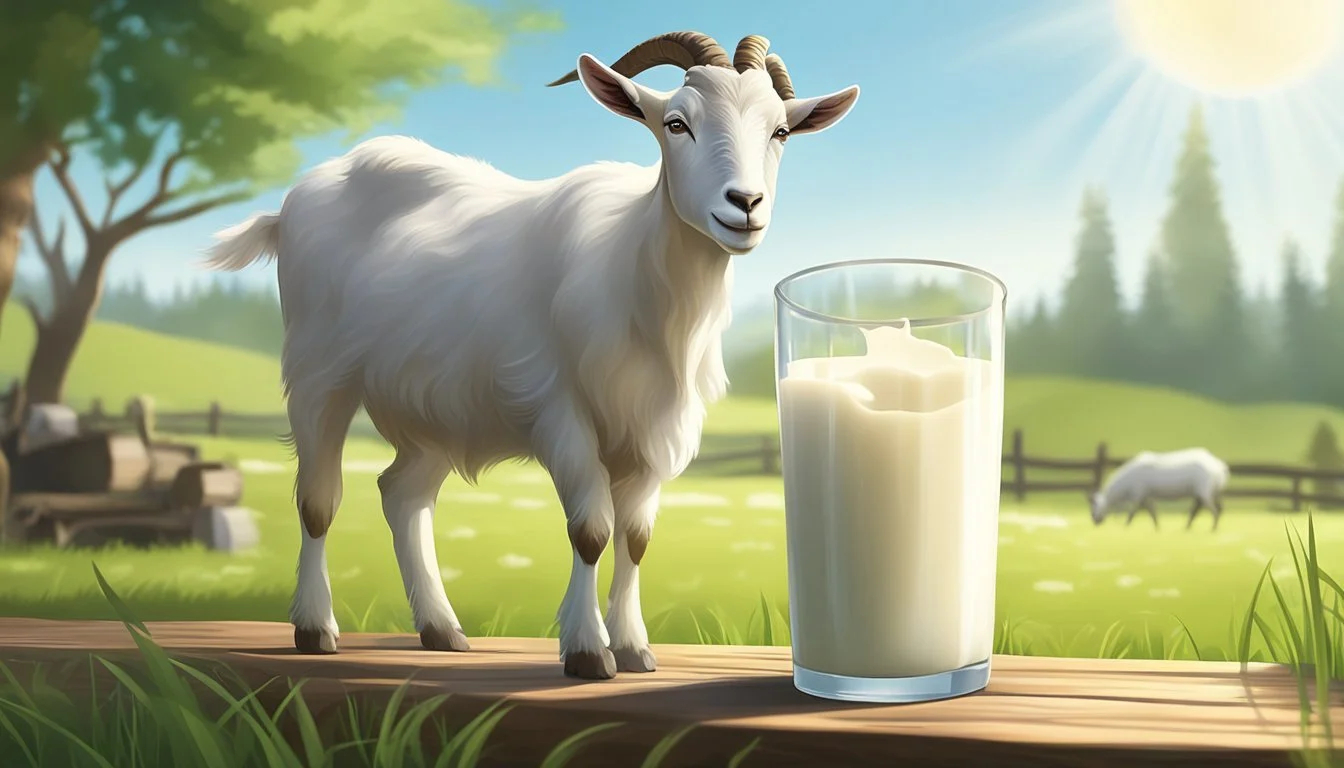The Science of Goat Milk
Benefits and Nutritional Breakdown
Goat milk has garnered attention not only for its nutritional offerings but also for its functional properties that set it apart from other milk types. The composition of goat milk is noteworthy; it contains an array of essential vitamins and minerals, making it an excellent addition to a balanced diet. Comparatively, goat milk proteins exhibit unique characteristics in their structure and benefits. These proteins have been found to be easier to digest and are less likely to cause allergic reactions than cow milk proteins. This enhanced digestibility is primarily due to the presence of smaller fat globules and a distinct casein profile.
The scientific community continues to investigate the functional properties of goat milk, including its potential as a source of bioactive peptides with antioxidative capabilities. Research has identified that fermented goat milk can lead to the production of these health-promoting peptides. Additionally, goat milk is rich in calcium, phosphorus, and magnesium, which are critical for bone health. The differences in protein structure, when compared to cow milk, may also influence how these minerals are processed and utilized by the body, thus bolstering the argument for goat milk's unique nutritional profile.
Consumers with sensitivities to cow milk have often turned to goat milk as a suitable alternative. This shift is due in part to its different protein composition and lower lactose content, which may contribute to its easier digestibility for some people. The beneficial effects of goat milk on human health continue to be an area of active research, with ongoing studies delving into how these differences impact nutrition and digestion at the molecular level.
Comparative Analysis of Milk Types
When analyzing different types of milk, it's essential to consider the nutritional content as well as the physiological benefits or drawbacks. The following subsections provide a closer look at how goat milk compares with cow milk and human milk.
Goat Milk vs. Cow Milk
Goat milk boasts certain advantages over cow milk, with a composition that sometimes makes it more suitable for people with sensitivity to cow milk. Goat milk contains smaller fat globules, which may contribute to easier digestion and quicker absorption. According to a nutrient profiling study, goat milk may offer greater ease of digestion and reduce symptoms in some gastrointestinal disorders when compared to cow milk. Additionally, goat milk can provide better absorption of iron and copper.
Moreover, goat milk has been observed to have higher levels of vitamin A and minerals like calcium, making it a considerable alternative for those looking to optimize their micronutrient intake. Research indicates that goat milk's properties can lead to improved bone density and might offer advantages in bone health.
Goat Milk vs. Human Milk
While goat milk and human milk differ significantly, especially in terms of their intended species, goat milk has been examined for its applicability in infant nutrition. One of the critical areas where goat milk shines is its protein composition. Some studies suggest that proteins in goat milk can have immunomodulatory effects and may possess antimicrobial and anti-inflammatory properties that contribute to its functional benefits.
However, compared to human milk, which is tailored for human infants, goat milk lacks some specific nutrients essential for overall growth and development. Thus, when goat milk is considered for infant consumption, it is often fortified to match human milk's nutritional profile more closely, ensuring that the modified goat milk can support an infant's need effectively. This fortification is particularly necessary for nurturing the gastrointestinal environment in a way that supports infant health, as human milk is naturally designed to do.
Nutritional Profile of Goat Milk
Goat milk is renowned for its dense nutrient composition, offering a rich source of protein, essential fatty acids, and an array of vitamins and minerals that are vital for maintaining good health.
Protein and Amino Acids
Goat milk contains high-quality protein, encompassing all the essential amino acids required by the human body. It is particularly noted for its ease of digestion and the presence of immunomodulatory proteins, which may play a role in allergy management and have potent anti-inflammatory effects.
Fats and Fatty Acids
While goat milk has comparable fat content to cow milk, it is distinct in its fatty acid profile. The fat globules are smaller, which might contribute to the ease of digestion. Goat milk is a source of essential fatty acids, which are crucial for growth and development.
Vitamins and Minerals
Goat milk is a good source of calcium, vitamin B12, and folate, important for bone health and metabolic functions. It also provides iron and other minerals, albeit in lesser amounts than cow milk. The nutritional value of goat milk is significant, particularly for those with dietary restrictions or allergies to cow milk.
Health Benefits and Therapeutic Potential
Goat milk stands out for its unique composition that contributes to numerous health benefits and therapeutic potential. It provides nutritional support, aids in the management of allergies, and exhibits biological effects like immunomodulatory, antioxidant, and antimicrobial properties.
Digestive Health and Microbiota
Goat milk facilitates better digestive health due to its functional properties that support a balanced gut microbiota. Studies suggest that it can improve the bioavailability of minerals, enhancing gut health and potentially aiding in the prevention of gastrointestinal disorders.
Allergy Management and Immunomodulatory Effects
The unique proteins found in goat milk can be less allergenic than those in cow milk, providing a viable alternative for those with cow milk allergies. Additionally, these proteins have been associated with immunomodulatory effects, which may benefit individuals with autoimmune diseases or allergies.
Antioxidant and Antimicrobial Properties
Rich in natural antioxidants, goat milk can help combat oxidative stress within the body. Its antioxidant effects, along with its antimicrobial properties, are instrumental in fending off infections and supporting the body's defense mechanisms against various pathogens.
Nutritional Support and Disease Management
Beyond its beneficial role in gut health, goat milk's nutritional adequacy makes it a substantial source of sustenance for people with diabetes and those needing tailored nutritional support. Its composition has been linked to therapeutic potential in managing chronic conditions like arthritis, asthma, and allergies, providing a foundation for disease management strategies.
Technological Aspects in Food Science
Goat milk's rise in popularity has brought significant attention to its technological aspects in food science. Researchers are particularly interested in its role as a functional food ingredient, its processing and stability, and its diverse applications in the food industry.
Functional Food Ingredient
Goat milk is valued for its functional foods component, especially its protein fractions which contribute to various health benefits. The unique emulsifying properties of goat milk proteins make them a preferred choice for enhancing the nutrient profile and functionality of food products. Dairy goats have thus become an integral part of goat milk production, offering high-protein yield that is essential for functional food development.
Processing and Stability
The thermal stability of goat milk lends itself well to food processing, ensuring protein yield is maintained through various treatment steps. During processing, it is critical to manage the sensory properties of the final product, as these can be influenced by changes in the milk's natural structure. The food processing sector continues to innovate methods to utilize goat milk components effectively while preserving its nutritional value and taste.
Food Industry Applications
In the food industry, goat milk products span a range of offerings from cheeses to yogurts, each benefiting from the milk's healthful properties and adaptability in recipes. Its functional foods designation stems from its naturally occurring bioactive compounds, which have positioned goat milk favorably in the market. The food processing sector has recognized that the milk's emulsifying properties and thermal stability are particularly useful in creating products that stand up to manufacturing demands while delivering on consumer expectations for both health and flavor.
Consumer Perception and Market Trends
Consumer perception greatly influences market trends, particularly in the niche but growing sector of goat milk products. Understanding these trends requires an in-depth look into product consumption and preferences, the burgeoning interest in nutraceuticals and fortified foods, and the impact of labeling and nutrient profiling on purchasing decisions.
Product Consumption and Preferences
Consumers are increasingly drawn to goat milk and its products, with a notable subset of the population expressing a willingness to consume these products. In some demographics, especially within countries like Mexico, Denmark, and Bangladesh, there's a marked preference for goat dairy which predominantly includes mature and fresh cheeses (What wine goes well with fresh cheeses?). The consumer choice towards goat milk products often stems from their taste, perceived health benefits, and dietary variety.
Popular Goat Milk Products:
Cheese (Mature and Fresh)
Ice Cream
Nutraceuticals and Fortified Foods
Goat milk is not only valued for its distinct taste but also for its potential as a nutraceutical. With proteins that may offer anti-inflammatory and immunomodulatory effects, goat milk is poised to be an attractive addition to the fortified foods market. Consumers are beginning to appreciate its health benefits, which has encouraged manufacturers to explore goat milk-based functional foods.
Potential Health Benefits:
Anti-inflammatory
Immunomodulatory
Labeling and Nutrient Profiling
Labeling plays a crucial role in informing consumers about the nutrient profiling of goat milk products. Accurate and clear labeling that reflects the product's nutritional values can sway purchasing choices, as more consumers now make decisions based on health considerations. The implementation of nutrient profiling on product labels can help highlight goat milk's beneficial components, such as its high solubility and beneficial protein content.
Labeling Highlights:
Protein Content
Vitamin and Mineral Fortification
Scientific Research and Literature
Extensive scientific investigations have revealed the distinctive properties of goat milk, with a focus on its bioactive components and the methodologies employed in its study. Distinguished journals and reviews have meticulously cataloged these findings.
Journal of Dairy Science Contributions
Journal of Dairy Science (JDS) has been instrumental in chronicling the advancements in goat milk research. Since 1917, over 850 research manuscripts have been disseminated, elucidating the differences between goat and cow milk, and the unique attributes of goat milk. A significant portion of these studies zeroes in on the bioavailability of nutrients in goat milk and the presence of bioactive peptides, which are instrumental for various health outcomes.
Review Methodologies and Findings
The review methodologies entail a systematic examination of scientific literature addressing the functional properties of goat milk. Studies often adopt protein coprecipitation methods to isolate and investigate bioactive components within goat milk. These findings suggest that goat milk proteins not only serve nutritional purposes but also possess functional properties that may contribute to health benefits.
Challenges and Considerations
While goat milk has many nutritional benefits, there are several challenges and considerations to take into account. This section will explore the potential for allergenic responses, the importance of authenticity in goat milk products, and the environmental and ethical aspects related to its production.
Allergenic Potential and Intolerance
Although goat milk is often considered a hypoallergenic alternative to cow milk, it does contain its own allergens. Casein and whey proteins present in goat milk could trigger allergic reactions in some individuals. It is crucial for consumers with milk allergies or intolerances to consult with healthcare professionals before incorporating goat milk into their diets.
Adulteration and Authenticity
Adulteration, the act of adding foreign substances to increase the quantity or alter the quality of food products, can be a significant issue with goat milk. Consumers should be vigilant about the legitimacy of goat milk products they purchase. Authenticity is vital to ensure the product's safety and nutritional integrity, and the functional properties of goat milk may be compromised if adulterated.
Environmental and Ethical Aspects
The production of goat milk entails environmental considerations, such as land degradation and water use. Ethical aspects also come into play, concerning the treatment and well-being of the goats in dairy farms. Sustainable and ethical farming practices are essential to minimize negative environmental impacts and to ensure the humane treatment of goats.
Conclusion
Goat milk's distinctive attributes set it apart from cow milk and other dairy options. It has a unique nutritional profile, characterized by high levels of short- and medium-chain fatty acids, which leads to its reputation for improved digestibility. Moreover, goat milk proteins exhibit properties that are potentially beneficial for health, such as anti-inflammatory and immunomodulatory effects, which may offer therapeutic advantages for various conditions.
Research indicates that goat milk proteins have functional characteristics that make them appealing for inclusion in a range of food products. The proteins' solubility and emulsifying qualities are especially noteworthy. These proteins, particularly in the form of coprecipitates, provide versatility in food applications, and techniques like coprecipitation are being explored for protein extraction.
The composition of goat milk also suggests a lower likelihood of causing allergic reactions compared to cow milk, attributed to its specific protein structure and lower lactose content. It is often considered a suitable alternative for those with sensitivities to cow milk.
Those interested in the nutritional aspects of their diet and the functional properties of the foods they consume may find goat milk to be an excellent choice. Continuing scientific exploration will further unravel the nutraceutical potential of goat milk, presenting opportunities for novel dietary and therapeutic applications.









